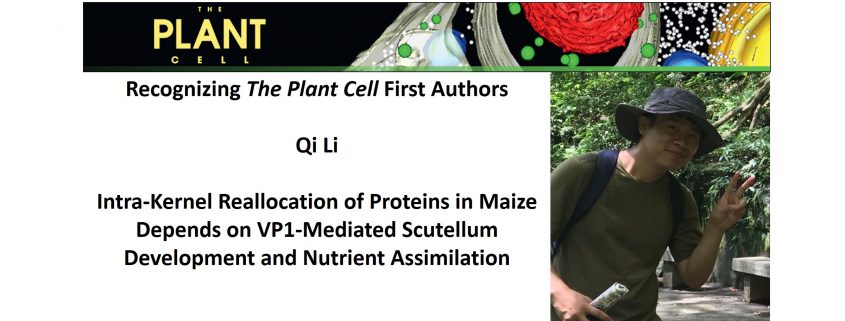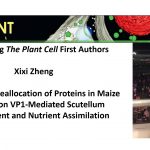Recognizing Plant Cell first authors: Qi Li
Qi Li, co-first author of Intra-Kernel Reallocation of Proteins in Maize Depends on VP1-Mediated Scutellum Development and Nutrient Assimilation
Current Position: Ph.D. student, Shanghai Institute of Plant Physiology and Ecology, China Academy of Sciences, 2014-present
Education: Bachelor of Agronomy, College of Agronomy & Biotechnology, China Agricultural University, 2010-2014
Non-scientific Interests: music, movies, and Chinese history
Brief bio: During 5 years of research as a Ph.D. student, I mainly focused on how maize kernel development (particularly storage filling) is regulated by transcription factors with domain-specific expression. In collaboration with my Ph.D. advisor Dr. Yongrui Wu and two senior researchers, I cloned the casual gene of the classical maize endosperm mutant floury3 (fl3), which encodes a PLATZ transcription factor and is specifically expressed in starchy endosperm region; and furthermore, is paternally silenced by genomic imprinting. Further analysis of FL3 protein revealed that it can interact with RNA polymerase III transcription machinery and impacts on tRNA and 5S rRNA transcription, ribosome biogenesis, and protein translation. After published this work, I put interests into dissecting the regulatory mechanisms underlying nutrient allocation between maize endosperm and embryo. My collaborator Xixi Zheng and I appreciated a protein-reduced transgenic mutant αRNAi, which non-pleiotropically drives the reduction of predominant endosperm storage proteins called α-zeins and compensatory increasing of other proteins in endosperm and embryo. Analyzing this mutant as a novel study system, we identified embryo-expressed globulin storage proteins and their regulator VIVIPAROUS-1 (VP1) in response to altered endosperm nutrient status. We detailed that VP1 not only has scutellum-specific expression at embryo maturation stage but also controls scutellum development and facilitates assimilation of endosperm-transferred nutrients in embryo. This newly-published study dissected how nutrient allocation in cereal endosperm and embryo is regulated; also, provided important information that VP1 exerts its regulatory effects on seed maturation and dormancy primarily in scutellum rather than in embryo axis (shoot and root apexes). In the future, I will try to understand the cis-regulatory imprinting control at Fl3 locus and VP1’s functions in early embryogenesis.
第一作者: 黎颀
当前职位: 博士研究生, 中国科学院分子植物科学卓越创新中心/植物生理生态研究所,2014至现在。
教育经历:农学学士,中国农业大学,农学与生物技术学院,2010至2014年。
兴趣爱好:音乐、电影、中国历史。
个人简介:在我攻读博士的五年里,我主要研究一些具有组织特异性表达的转录因子调控玉米籽粒发育(特别是营养物质积累)的功能机制。2017年,在导师巫永睿研究员的指导下,我和课题组两位工作人员合作克隆了经典的玉米粉质胚乳突变体fl3 (floury3)。我们的结果发现Fl3基因编码一个PLATZ家族的转录因子,特异在淀粉胚乳区域表达,并受到印迹控制由母本基因组来表达。进一步的蛋白功能分析揭示,FL3可以与RNA聚合酶III复合体成员互作,调控tRNA和5S rRNA转录。在fl3突变体中FL3蛋白的显性突变负面影响了核糖体组成以及蛋白翻译过程。完成此项工作后,我和同年级研究生郑喜喜一起试图解析另外一个重要的科学问题——玉米籽粒胚和胚乳如何在灌浆时期实现协调的营养配置。我们利用了一个醇溶蛋白RNAi敲低转基因株系αRNAi作为研究系统。αRNAi可以非多效性降低玉米胚乳中最主要的α-醇溶蛋白的积累,并增加非醇溶蛋白在胚和胚乳中的合成,从而实现胚和胚乳之间蛋白营养的重新配置。利用该系统,我们发现胚特异表达的球蛋白基因及其转录调控因子VP1 (VIVIPAROUS-1)参与了响应过程。研究表明,VP1在胚成熟后期特异表达在盾片中,并直接控制盾片发育和胚乳营养传递至盾片后的同化。我们这项工作不仅揭示了在谷物灌浆过程中胚和胚乳之间营养配置的新机制,也为谷物穗发芽以及种子休眠相关研究提供了新的信息,即VP1主要在子叶(盾片)中发挥调控功能。未来,我将试图在以下两个方面开展研究:1)Fl3的顺式印迹调控机制;2)VP1在早期胚发育过程中的功能。




